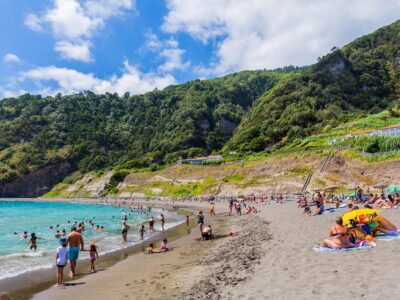
Pleasant temperatures in the high 60s (Fahrenheit) and minimal days of rain make June a great time to visit the Azores for those looking to spend time at the beach and hiking. Ferries and planes will be on their frequent summer schedule, making it easy to island hop, and as the Azores rarely gets packed, you can still enjoy quiet beaches and empty trails.

With spring just around the corner and the winter rains easing, March is a beautiful time to visit the Azores. Pleasant temperatures are ideal for hiking, and cooler evenings are perfect for relaxing in São Miguel's natural hot springs. Wildlife lovers will have the chance to spot migrating whales and resident dolphins, and cheaper accommodations are great for budget-conscious travelers.
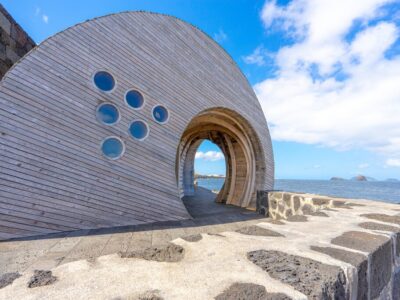
July is the most popular and one of the best months to visit the Azores. Summer is in full swing, and temperatures range from the mid-60s (Fahrenheit) to the mid-70s. Top that with limited rainfall, light winds, and 14 hours of daylight, and you'll have plenty of time to hike, kayak, and swim your way around the islands. Accommodation prices will be higher than in winter, but as the Azores rarely get crowded, you can enjoy quiet beaches and empty trails if you head away from the main tourist spots.

May is a great time to visit the Azores to take advantage of the quiet trails and warming temperatures. With the winter rains receding and the islands lush and green, you can enjoy plenty of sunny days ideal for hiking, whale watching, and island hopping. Accommodation prices will still be lower than in the busy summer months, except during Santo Cristo, when thousands of visitors arrive in Ponta Delgada to participate in a large festival and procession.
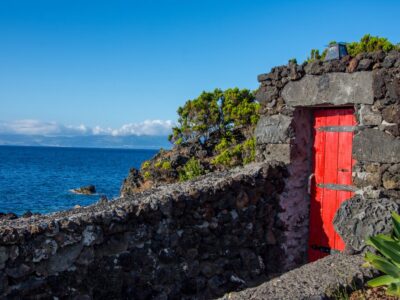
Plan a trip for early summer or fall to enjoy the best the Azores offers, including beautiful coastlines, lush forests, and otherwordly geothermal features. June and September are especially excellent months to visit, with minimal rainfall, pleasant temperatures, and plenty of wildlife out and about. The busier summer season is best for beach-goers and island-hopping, while winter is great for hiking and soaking in natural hot pools.

January is a great month to visit the Azores for nature enthusiasts and hearty adventurers. Towns and trails will be at their quietest, and once pricey accommodations can be yours for a fraction of the cost. Cooler temperatures are perfect for soaking in the picturesque hot springs on São Miguel and hiking Terceira's lush trails.
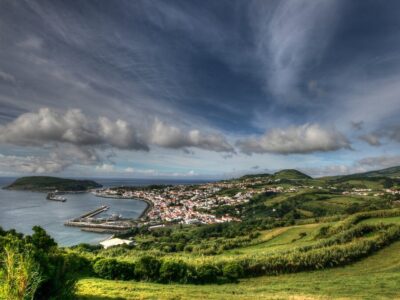
Cheaper accommodations and lingering summer temperatures make October a great time to visit. You can look forward to days in the mid to high 60s (Fahrenheit), with an occasional day of rain. Those looking for a relaxing vacation can spend their time between the beach and the hot springs, while nature enthusiasts will love hiking the lush forests and quiet coastal trails.

Seven or eight days is an ideal amount of time to spend in the Azores. Travelers with only a week to explore the Portuguese archipelago can focus their time on the island of São Miguel, adding on a trip to Terceira for whale watching if they have an extra day or two. Those with two weeks to spare can opt for a more comprehensive trip around the Azores, exploring four of its islands, or integrating an Azores excursion into a larger Portugal trip, including Lisbon and the Duoro Valley.

November is the tail end of fall in the Azores and offers a mix of sunny days, spots of rain, and cooler nights. Nature enthusiasts will love hiking through the lush landscapes, while those looking for a relaxing vacation can head for the natural hot springs dotted across São Miguel. While less frequent, some days in early November are still warm enough to soak up the sun at the beach and enjoy a refreshing swim.
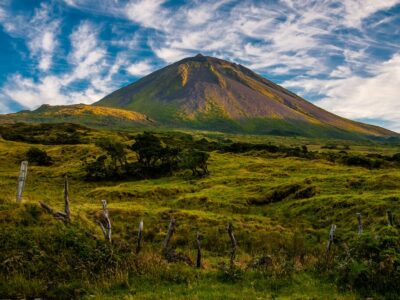
With pleasant temperatures and fewer crowds than in July and August, September is one of the best times to visit the Azores. Sea temperatures are perfect for swimming and snorkeling, and calm oceans are ideal for spotting the last of the migrating whales passing through. Expect the occasional rain shower, but you can enjoy the lush landscapes the Azores are known for in return.
